

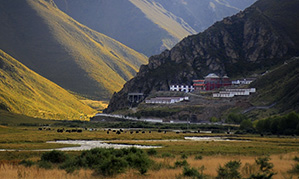
Dorje Niyngpo (rdo rje snying po) was one of the main disciples of Kyobpa Jigten Sumgön (1143-1217). He attained magical powers and eventually travelled from Central Tibet (Ü-Tsang) to Eastern Tibet (Dakham, mdo khams) to a place called She’u (zhe’u). One night he had a dream in which he saw extraordinary signs that were in accordance with what was prophesized by Kyobpa Jigten Sumgön. The next day he went to the Nyidzong Valley. He carefully scrutinized the area, as well as the specific place where the present monastery stands. All favorable conditions (rten ‘brel) had come together there.
The place was perfect and hence Dorje Niyngpo realized that this was the right place. In the year 1188 they started building the Nyidzong (nyi rdzong) Monastery.
At this place there is a mountain called Wenri (dben ri), meaning an isolated mountain, distant from human settlements. There on the mountain Wenri the monastery was built. It is part of a mountain range which has the same quality as the great intellectual masters Guru Rinpoche (Padmasambhava), Lochen Berotsana (lo chen be ro tsa na), Lushabpa Jigten Sumgön (klu zhabs pa ‘jig rten gsum mgon), Kunkhyen Chökyi Drakpa (kun mkhyen rig ‘dzin chos kyi grags pa) and so forth.
On this mountain range Dorje Niyngpo executed a consecration and said: “This is a very sacred place. If you practice for one day in this area it would be equal to practicing one year in another place.” In this way he opened up this specific mountain range as a powerful place for retreats.
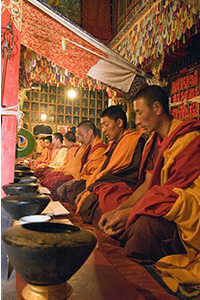
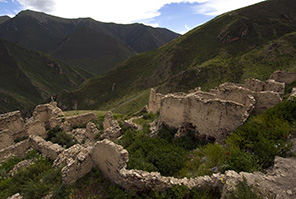
The reincarnation of Kham Dorje Nyingpo, Nyidzong Trichen Konchog Namgyal (nyi rdzong khri chen) became one of the three leading regents of the Drikungpa in Eastern Tibet. The two others are the heads of Lho Lungkar Gön and Gar Gön. The three together are known in short as Lho Gar Trisum (the Lhochen, Garchen, and Trichen Rinpoches respectively). Nyidzong Trichen uttered the prophecy: “In the future this monastery will have great potential to make the Drikung Kagyu Lineage flourish. In the future we will have the good karma to gather again at this place.” Then he left his footprint there. It was said that in the future when the three favorable conditions come together his footprint will naturally reappear.
As he said then and as has been prophesized by the earlier masters, the lineage of the father will always be continued by the son.
On that mountain Wenri they build a retreat center. That was sort of the beginning. During the time of the first Nyidzong Trichen the Drikung Kagyu Lineage was first introduced in that area. Then gradually mainly Nyidzong Trizur (khri zur) and a large number of monks and nuns have brought the Drikung Kagyu Lineage to grow with a philosophical school and a retreat center. Since then the Drikung Kagyu Lineage was firmly established in Domé in the monastery Nyidzong Tegchen Shedrup Chökhor Ling.
Much later, during the time of the Chinese occupation in the middle of the last century, the monastery and lineage degenerated. Then again, like the sun rising in the early morning, the monastery and the lineage rose up again. The Rinpoches of the monastery took the responsibility and the older monks started to rebuild the monastery and the lineage in Dokham. As per the wishes of the monastery, in 2005 Zurtrul Konchog Tenzin Ngedön Lungtog Gyatso (zur sprul dkon mchog bstan ‘dzin nges don lung rtogs rgya mtsho) took the main responsibility. They changed the place where the new monastery was built. As had been prophesized by the earlier masters, at that time the footprint of Nyidzong Trichen Konchog Namgyal naturally appeared. In addition, on the cliff at the right side of the mountain the letter Hung naturally appeared and several other supernatural occurrences were observed.
Then the Drikung Kyabgon Chungtsang was invited to Kham and he turned the wheel of Dharma and consecrated the new monastery. Zurtrul Rinpoche took the responsibility and with the aid of monks, sponsors, and people of the area they were able to establish the great new monastery. The monastery complex is made up of various buildings.
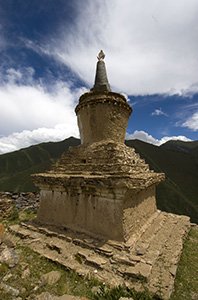
In the east Dorsem Ling (rdor sems gling) in the south Rinchung Ling (rin ‘byung gling), in the west Nangtha Ling (snang mtha’ gling), in the north Jang Dönyö Ling (byang don yod gling), and in the center the wonderful temple of Phuntsok Tagten Ling (phun tshogs rtag brtan gling).
Moreover there is a shedra and retreat center and an Apchi Lhakhang. There is also the famous sky burial cemetery. The temples are filled with many beautiful statues and chörten. The foremost statue of the Buddha in the main temple is more than ten meters high and made of gold, copper and silver. Two large statues of Guru Rinpoche and Jigten Sumgön are also kept in this temple. An unbelievable number of further statues can be seen in the monastery. When rebuilding the temple they brought the relics of the Buddha from the old statues and filled them into the now ones. Also a bone from the head of Atisha is kept at Nyidzong Gön, as well as Rigdzin Chökyi Drakpa’s seal made of ivory and the ritual dagger (phur ba) of Gyalwang Rinchen Phuntsog made of meteoritic iron.
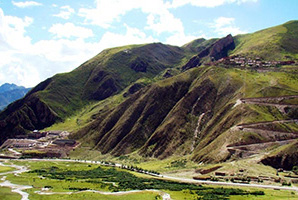
One Lama and one Tulku are presently abiding in the monastery, as well as Drubpöns, Khenpos and Lobpöns, and in total over 100 monks. In Kham the Lama Dance from Gar Monastery (Gar Cham) is very well known. But there is a also a very special dance at Nyidzong Gön called the Nyidzong Shitrö (zhi khro), a peaceful and wrathful dance of the goddess which involves very complicated steps. This dance is very renowned far and wide. In the Upper and Lower Shedra classes are taught by Khenpos and Lobpön and 70 monks are currently studying there. In the retreat center the Fivefold Path of Mahamudra and the Six Yogas of Naropa are always being practiced without interruption. The present Nyidzong Trichen is the 15th and the present Trichung Rinpoche is the 12th, while there is the 9th and the 7th Zurpa Rinpoche.

